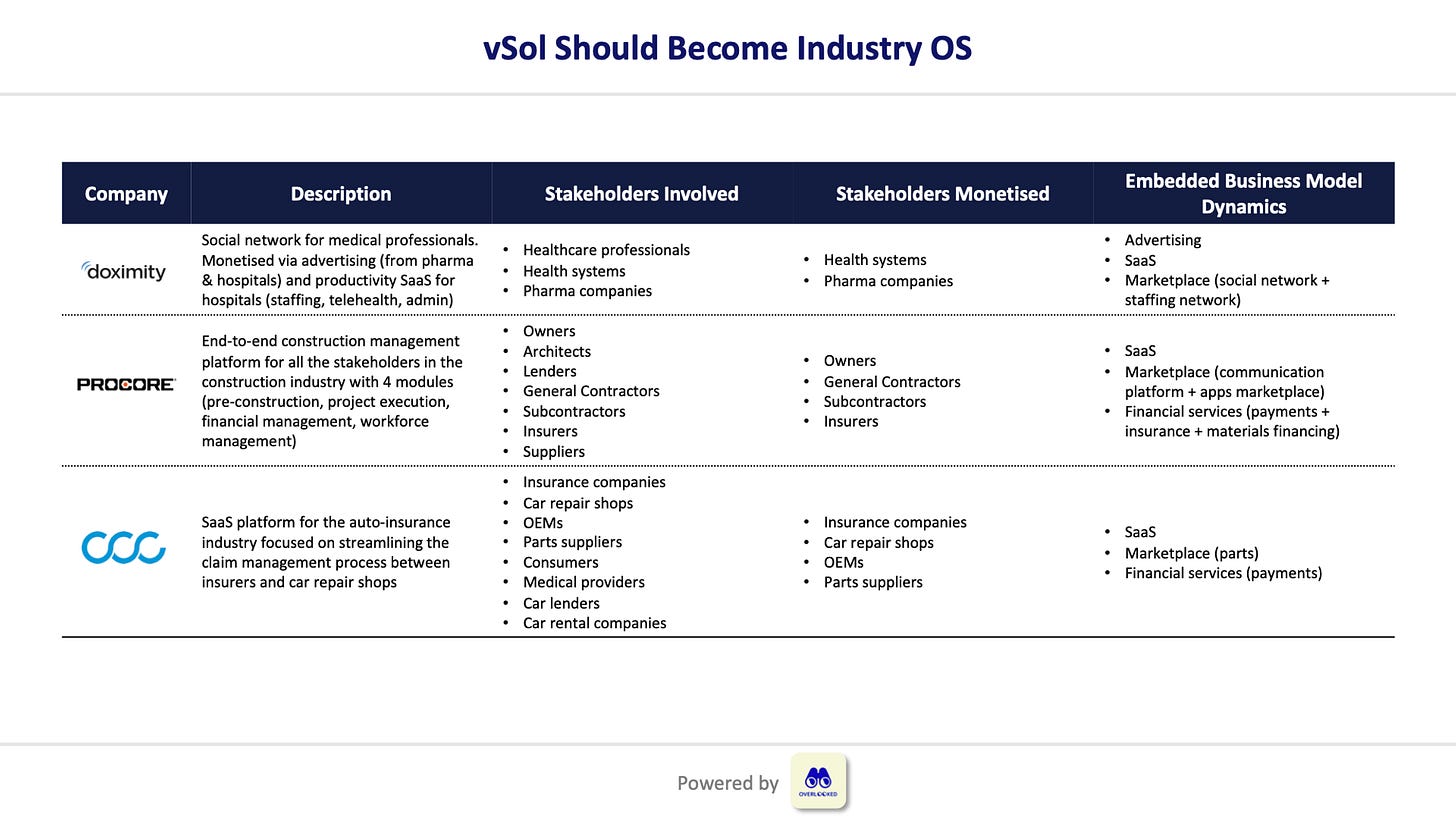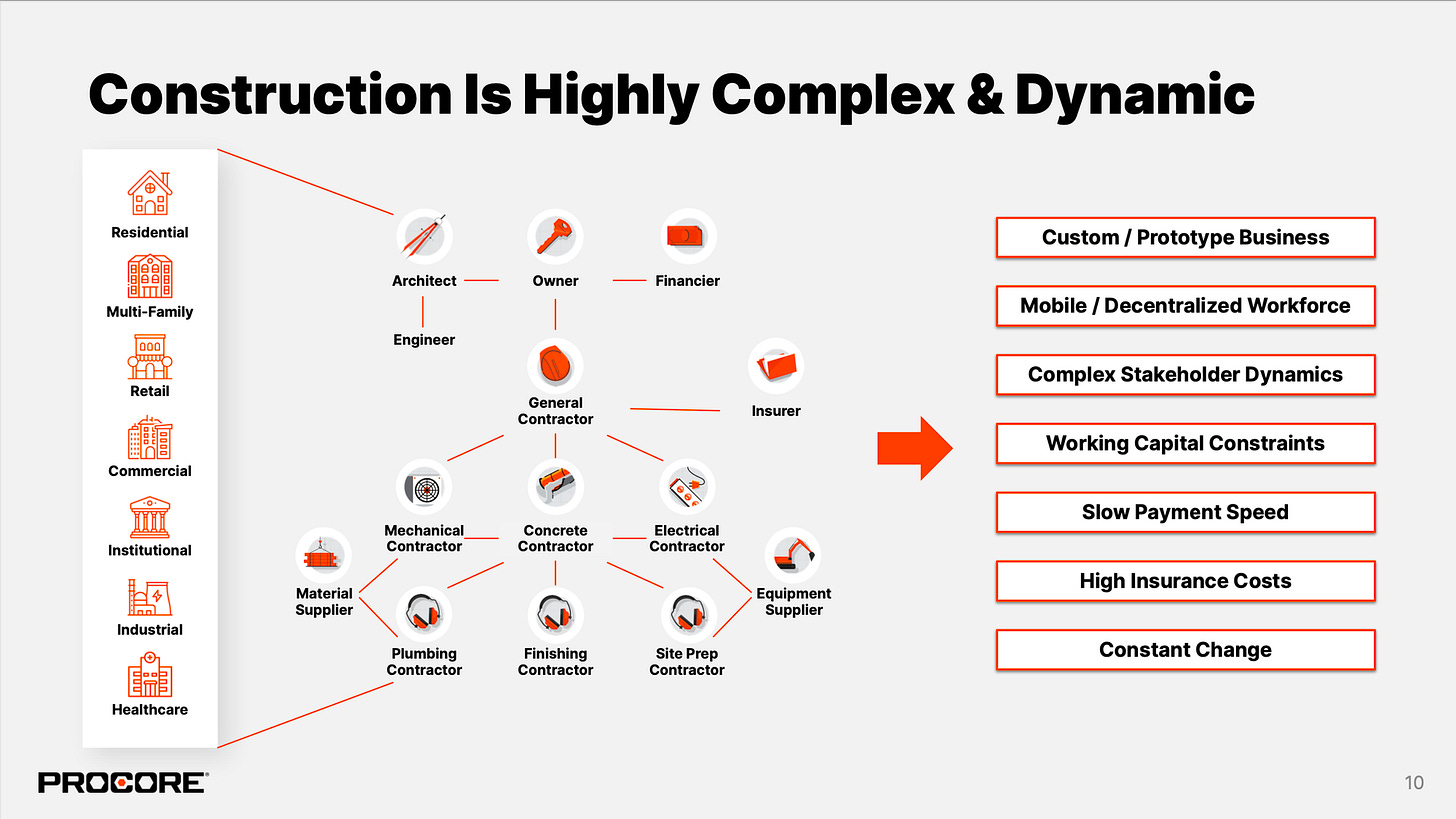❄️ vSol as an Industry Operating System
Overlooked #161
Hi, it’s Alexandre from Eurazeo. I’m investing in seed & series A European vertical solutions (vSol) which are industry specific solutions aiming to become industry OS and combining dynamics from SaaS, marketplaces and fintechs. Overlooked is a weekly newsletter about venture capital and vSol. Today, I’m sharing a personal investment thesis on vSol as industry operating systems (OS).
This is the third article in my series dedicated to the construction industry. In my previous pieces, I covered Procore and ServiceTitan which are both category leaders in the construction industry. The last article of this series will be around startup trends in the construction industry. If you build or invest in the construction industry, I’d love to meet you! You can reach out at adewez@eurazeo.com.
The best vertical Solutions (vSol) have the potential to evolve into industry operating system (OS) building and monetising products for multiple stakeholders in the industry they target. It enables vSol to (i) significantly increase their addressable market, (ii) create defensibility through network effects and (iii) integrate additional business models into their platform.
In this post, we will explore three vSol that have successfully become industry OS (Procore, CCC and Doximity) and we will discuss the benefits of being an industry OS.
Part 1 - Exploring Case Studies
Procore
Procore is a construction management software centred around breaking communication silos between stakeholders in a construction project. Founded in 2002, it went public in May 2021, made $720m in sales (40% YoY growth) during its last fiscal year and has a $8.5bn enterprise value (as of Aug. 2023) trading at a 8.3x EV/NTM Sales multiple.
As we discussed in the Procore’s deep-dive, there are multiple stakeholders involved in a construction project, including:
The owner: the individual or organization that owns the assets and initiates the construction project.
The general contractor: the construction professional responsible for the overall execution of the project, often delegating most construction work to subcontractors.
The subcontractors: specialists in trades such as plumbing, electrical, and HVAC, selected by the general contractor to handle specific portions of the construction project. There can be several layers of subcontractors delegating work to each other.
The suppliers: entities that provide materials to the subcontractors.
The financier: the source of loan or equity financing for the project, with funds released progressively based on construction achievements.
The insurer: the provider of insurance coverage to all stakeholders in the construction project.
Procore started as a project management product, initially sold to general contractors. It was designed to facilitate communication between subcontractors and field workers on one hand, and owners and architects in the office on the other. Procore introduced a unique business model that was not tied to the number of users—which could have deterred usage—but instead linked to the construction volumes processed on the platform. Even at this early stage, Procore positioned itself as an “industry OS”. While it primarily monetized general contractors, it was also building products and delivering value to multiple stakeholders in the industry.
Over time, Procore evolved from offering a single product (project management) and monetising a single stakeholder (the general contractor) to becoming a comprehensive platform with multiple products catering to various stakeholders, including owners, general contractors, and subcontractors. Some products are tailor-made for specific stakeholders, like workforce planning for subcontractors, while others, such as project management, are utilised by several stakeholders.
Moreover, Procore has integrated business model dynamics into its platform that extend beyond its original SaaS business model. On the one hand, it launched an app marketplace in 2016 to complement its offering. Today, this marketplace boasts over 400 applications. The more integrations customers have with third-party apps, the more entrenched Procore becomes in their operations, leading to increased revenue for Procore. On the other hand, Procore is expanding into financial services, including payments, insurance, and financing. This move involves engaging with insurers and financiers, stakeholders Procore had not directly served before.
This positioning as an “industry OS” makes Procore extremely defensible. It creates a natural flywheel effect: the more construction companies and workers use Procore, the more value it provides to its customers, thanks to the data collected.
CCC
CCC is a SaaS provider for the US auto-insurance industry, streamlining the relationship between auto-insurers and car repair shops, where insured individuals and businesses have their cars repaired. Founded in 1980, CCC went public in Aug. 2021. It made $782m in sales (13% YoY growth) during its last fiscal year and has a $7.2bn enterprise value (as of Aug. 2023) trading at a 8.1x EV/NTM Sales multiple.
CCC serves all the stakeholders in the auto insurance industry. Insurers (50% of revenues) and car repair shops (43% of revenues) are its primary stakeholders. However, CCC also facilitates connections between them and other parties such as OEMs, parts suppliers, recyclers or lenders.
For insurers, CCC offers a SaaS solution to digitise their auto-insurance related workflows. This includes estimating vehicle damage, facilitating vehicle repair, covering personal injuries, and managing the process for cars destined for the scrapyard. It works with 300 out of the 1k auto insurance companies in the US capturing a 30% market share. Notably, it serves 27 of the 30 largest companies (representing a 90% market share among them) which generate 85% of auto insurance premium.
For car repair shops, CCC’s SaaS solution streamlines the operations of their repair shops, particularly the workflows associated with insurers. It has 29k collision auto repair shops as customers out of 40k in the US, holding a 73% market share.
As a result, CCC has become the de facto infrastructure of the US auto-insurance industry, facilitating interactions between its two main stakeholders: insurance companies and car repair shops.
Today, CCC is taking further steps to solidify its position as an “industry OS”. On one hand, it is integrating additional stakeholders like lenders, OEMs, and parts providers. On the other, it is diversifying its business model by introducing financial services around B2B payment flows between insurers and car repair shops, and launching a parts marketplace for car repair shops.
Doximity
Doximity was founded in 2011. It’s a social network for healthcare professionals in the US. It went public in Jun. 2021. It made $419m in sales (22% YoY growth) during its last fiscal year and has a $3.5bn enterprise value (as of Aug. 2023) trading at a 7.2x EV/NTM Sales multiple.
Functioning as a verticalised Linkedin for the US healthcare industry, Doximity boasts 80% of physicians, 90% of medical graduates and 50% of nurses using its mobile app. These healthcare professionals utilise the app for various purposes, including reading medical news, networking with colleagues, job searching, administrative tasks like document signing, and medical workflows such as telemedicine.
Doximity is free for healthcare professionals. It successfully monetises its robust user base by offering additional paid products to other stakeholders in the healthcare value chain. This strategy has proven effective, as all of the top 20 pharmaceutical companies and the top 20 hospitals in the US use Doximity. The platform offers advertising solutions to pharmaceutical companies and provides advertising, hiring, and productivity solutions to hospitals.
Doximity's defensibility lies in its social network structure, which creates network effects concentrating usage among healthcare professionals and advertising budgets from pharmaceutical companies and hospitals.
Part 2 - The Benefits of Being an Industry OS
Increase your Addressable Market
By serving multiple stakeholders in your industry, you can significantly expand your addressable market through three main levers:
Increase the number of addressable customers. For example, CCC addresses both the 400 auto-insurers and the 40k car repair shops in the US.
Unlock indirect monetisation. When targeting SMBs or consumers, there's a limit to their willingness to pay. Serving other stakeholders who interact with these SMBs and consumers can allow for indirect monetization and surpass this limit. For instance, while healthcare professionals on Doximity may not be willing to pay for a social network, the hospitals they work for and the pharmaceutical companies are willing to pay to access this qualified audience.
Monetise the same product multiple times. Procore illustrates this concept with its “triple TAM”, highlighting that it can monetize construction volumes processed on its platform multiple times. When an owner, a general contractor, and a subcontractor collaborate on Procore’s project management product, each becomes a potential paying customer for the same product.
Create Defensibility thanks to Network Effects
Becoming an industry OS enhance the defensibility of a vSol by creating network effects concentrating workflows from different stakeholders within an industry on a single platform.
Most vSol don’t have natural network effects. Doximity as a social network and Procore as a communication platform are exceptions due to the nature of their initial product. A common challenge for SaaS-only vSol is a lack of defensibility. This issue becomes more pronounced in overcrowded industries, such as the restaurant or beauty sectors
Transitioning from company OS to industry OS can foster network effects, thereby enhancing defensibility. For example, CCC is a superior business to a Shopmonkey and Doctolib is a superior business to Docplanner by incorporating network effects into its original model, whereas its counterparts have remained within a SaaS-only framework.
Integrate Additional Business Models in your Platform
By serving various stakeholders in an industry, a business often becomes central to common workflows and relationships. This centrality creates opportunities to incorporate additional business models into the platform.
For instance, financial services can be tied into the platform, such as payments between general contractors and subcontractors for Procore, or payments between insurers and car repair shops for CCC.
Additionally, marketplaces can be integrated, like a parts marketplace for car repair shops by CCC, or a recruiting marketplace for health systems by Doximity.
Advertising is another avenue, exemplified by Doximity, which facilitates pharma and healthcare advertising targeted at healthcare professionals.
Thanks to Julia for the feedback! 🦒 Thanks for reading! See you next week for another issue! 👋





